
The Calico .22 Light Weapons System
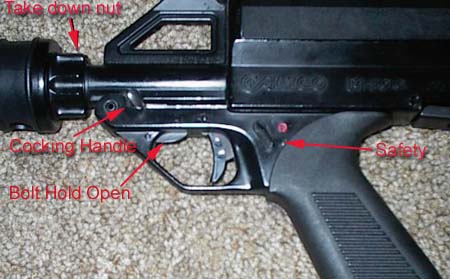
Pistol, and rifle versions of these neat little guns are available, along with a number of accessories. As with the 9mm version, the rifle and pistol variants of the Calico are mechanically identical, and similar in most other respects. The Pistol version is a classic, simple blowback pistol except for the placement of the chamber and the deployment of the magazine. The chamber is a bit farther forward than it would be on a standard pistol. Unlike the 9mm versions, the .22 Calico ejects to the side in the conventional manner, though both calibers feed from the top. The pistol grip is hollow, and empty. The magazine sits atop the receiver rather than in the grip, and is the defining feature of the weapon. These top mounted, helical drum magazines will have their own section. Overall, the guns do not have the fit and finish of the 9mm versions, though they are still well above the standards of the average .22. The construction is of polymer, and metal, and the guns seem tight, and well fitted.
The 100 round magazine was the predecessor to the Calico 9mm mags. This is the original version with the winding knob; later versions had a crank. The knob is given 15 full turns after the magazine is loaded and the initial tension is taken off. Unlike the 9mm magazines, these have no sights molded into them. The sights are mounted, M-16 style, high above the bore. This is done to clear the top mounted magazine, rather than being an attempt at recoil reduction, as it is on the M-16. The plastic bodied magazine has aluminum feed lips, but they are fixed in place, unlike the spring loaded types of the 9mm version. This means that a speed loader can not be used with them as it can with the 9mm mags. There is a row of clear windows on top of the magazine to indicate the number of rounds remaining. In most ways the .22, and 9mm mags are very similar.
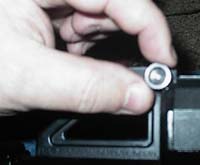
The high mounted sights are adjustable for windage at the rear, and elevation at the front
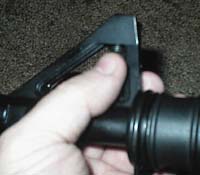 post. Though the sights are very reminiscent of those on the M-16, the rear
sight is a notch rather than a peep, and no special tool, or cartridge is
required to set the sights. Both are adjusted using knurled knobs with a positive
click action. There is also a scope mount available, which is designed as
a cage to fit around and over the magazine.
post. Though the sights are very reminiscent of those on the M-16, the rear
sight is a notch rather than a peep, and no special tool, or cartridge is
required to set the sights. Both are adjusted using knurled knobs with a positive
click action. There is also a scope mount available, which is designed as
a cage to fit around and over the magazine. The non-locking bolt is simplicity itself. There is a spring loaded extractor on the bolt face, while the ejector is a long sliver of steel which fits into a notch in the receiver, and doubles as a guide for the bolt by fitting in a recess milled into the bolt's upper surface. There is also a spring, and guide rod, along with a buffer. The entire assembly removes as a unit, and is quite easy to clean. During disassembly, care should be taken to insure that the ejector does not detach itself, or the recoil spring does not go flying off into space. The cocking lever is a separate casting which is permanently pinned to the bolt, and reciprocates along with it as the weapon is fired. The entire assembly is made from steel forgings, except for the ejector, which is made from spring steel. Reassembly is best performed by replacing the bolt into the lower receiver, and fitting the ejector into it's notch at the rear of the receiver. The two receivers are then joined together, and the bolt is pulled back, just a bit before securing them. With the magazine removed, the bolt can be clearly seen, and the weapon bears a strong resemblance to it's bigger brother in 9mm.

There is no 50 round magazine for the .22 Calicos, as there is for the 9mm version, the 100 being the only option. The pistol version of the gun has a very nice, stable balance, with the center of gravity sitting almost directly over the wrist. This has much the same feel as the old Bushmaster .223 carbine, or some of the other, small bullpup designs which hit the market a couple of decades ago. In comparison to each other, the rifle has a longer barrel which is shrouded, in contrast to the short, exposed barrel of the pistol. The rifle also has a stock, which folds on some versions of the pre ban models.
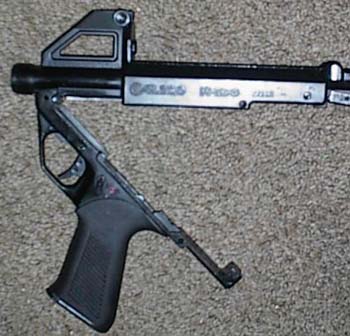 This is an actual folding stock, rather than the telescoping type employed
by the 9mm version. The barrel removes from the rifle for storage, or transport,
and makes the gun a very small package indeed, particularly if it is one
of the older, folding stock, models. There is a "dress" version of the carbine,
which sports a nice walnut stock. There is also a post ban "folding" version
in which the stock is pinned to prevent it from being folded. as of this writing,
I now own both versions of the .22 calico, a standard pre-ban pistol, and
a folding stock, preban carbine.
This is an actual folding stock, rather than the telescoping type employed
by the 9mm version. The barrel removes from the rifle for storage, or transport,
and makes the gun a very small package indeed, particularly if it is one
of the older, folding stock, models. There is a "dress" version of the carbine,
which sports a nice walnut stock. There is also a post ban "folding" version
in which the stock is pinned to prevent it from being folded. as of this writing,
I now own both versions of the .22 calico, a standard pre-ban pistol, and
a folding stock, preban carbine.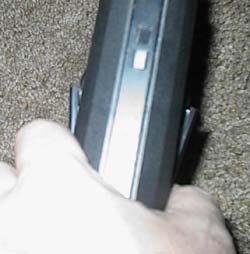
The styling of the gun clearly sets out to mimic that of the M-16, even to the extent of the shape of the barrel sleeve, and the method of field stripping. The weapon is field stripped by removing two pins, and tipping the upper receiver forward. The bolt then drops out of the upper receiver. Barrel removal is not required for cleaning, once the action is open. The magazine should be removed first, and the weapon should be cocked. The magazine is removed in the manner of the 9mm version, by depressing a matched set of locking levers on either side of the gun's receiver, and pulling straight up.
As far as lethality is concerned, I would say that 100 rounds of anything this side of a spitball could be considered plenty lethal. In truth, the .22 is a lot more cartridge than most people give it credit for. A high velocity .22 will have a touch over 140 foot pounds of energy. A hyper velocity round will muster a bit over 170 foot pounds; the same amount of energy contained in the .380. The .380 is considered to be a marginal, but adequate (depending on who you talk to) man stopper. This is the round used in the Walther PPK, the Colt Mustang, and a number of Beretta models. It has, at one time or another, been adopted by military, and/or police organizations of several nations. If this round is good enough for James Bond to fire out of his Walther, a round which can equal it's energy ought to be good enough for me; particularly when I have 100 of them on tap. A separate section of this site will go into detail about the .22 cartridge.

This was clearly the starting point for the 9mm model, as the two weapons greatly resemble each other in general layout, as can be seen by comparison to the photos of the 9mm versions with their magazines off, though the action differs greatly. With the magazine removed, as in the accompanying photo, the bolt can clearly be seen. The magazine catches, on either side of the rear of the receiver show up plainly. Also visible is the locking lug for the magazine at the front of the receiver, as well as an indexing pin between the magazine catches at the rear.
Though the pistol version has been little changed, and little modified since it's inception, there have been a number of different versions of the carbine. Some variants were simple style changes, others were mandated by that misbegotten piece of legislation misnamed the crime bill of 1994. Apparently, we may no longer be trusted with, even a .22, that can hold more than 10 rounds in it's magazine. These guns are now selling used for over twice what they sold for when new. The magazines, when they can be had, sell for about four or five times what they sold for when new. This is the usual result of government interference in our lives, and little more needs to be said on the subject. Presently, there is a nice, full stock version available with handsome walnut fittings. The original models had a folding stock, though later, an option to add a standard stock was offered. A full line up of all of the different models is given on one of the pages in my links section.
Below is an exploded view drawing of the original Calico helical drum magazine. This is the magazine that started it all. This magazine works in the same fashion as the 9mm version, and further details, as well as a link to the patent, may be found on the magazine page. There will be no seprate page for the .22 magazines, but the ways in which it differs from the 9mm version will be covered here. This magazine is loaded, one round at a time, through the feed lips. The winding knob, or crank, is given a couple of turns first, until the follower is visible. As the magazine is loaded, a button in the middle of the winding knob may be depressed to take some of the tension off, and ease loading. When all 100 rounds have been loaded, all tension should be released, and the winding knob rotated 15 full turns. This will make the magazine ready to be used. The spring tension may be left off the magazine, if it is to be stored loaded for extended periods of time. It may then be wound, just prior to use. Clicking on the drawing below will bring up a full sized version.
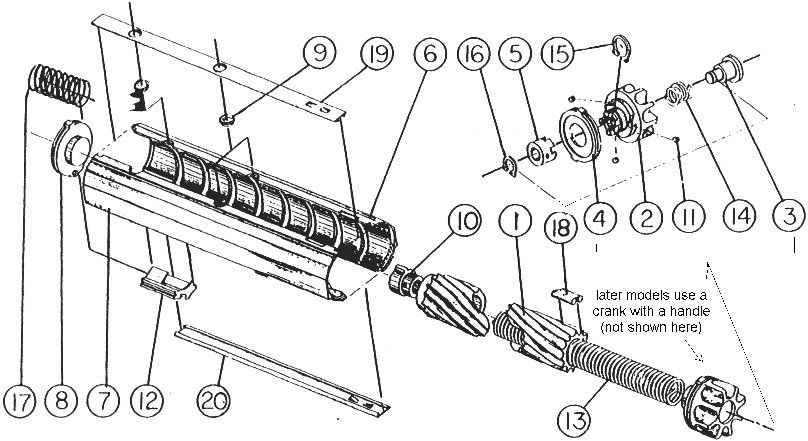
There is an M-100, along with a M-100P in my collection, but Calico has made several other models, primarily of the carbine, in an effort to skirt the new gun bans. Though I do not own any of these guns, I have managed to find photos and descriptions of them on the web. Those who have a real interest in the company, it's history, and the models produced, are directed to my links section. There is a sight which gives a pretty good listing of the different models produced, and their dates of production. It also gives the original prices, for those who want to kick themselves for not getting one of these trend setting weapons when they could still be easily had. I have a listing f the primary models of the .22 in the table below. The photos were taken from on line auctions of the guns in question. Their quality varies. Clicking on the small image will bring up a full sized one.

|

|
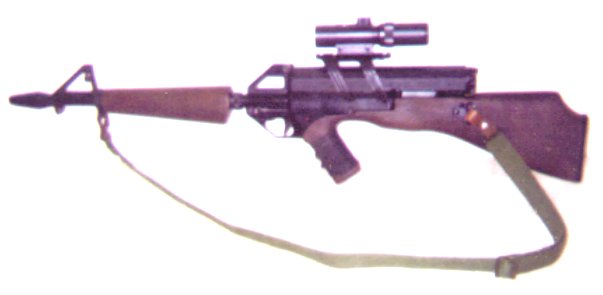
|

|